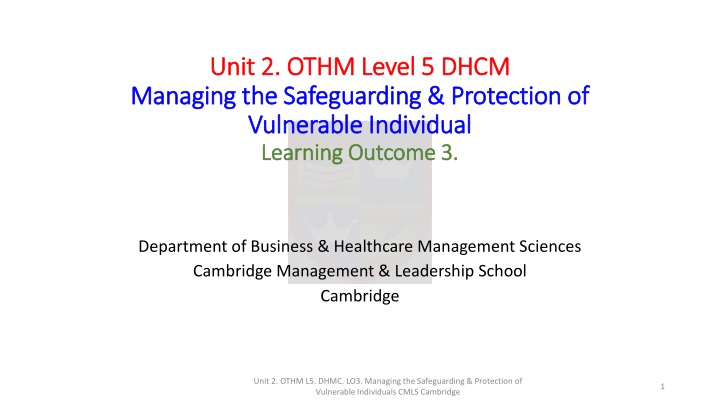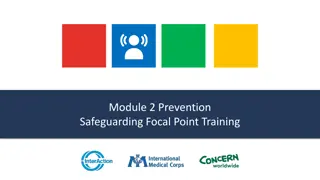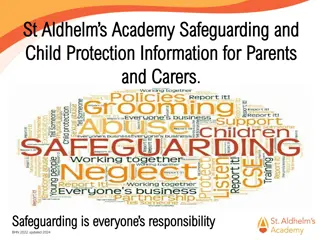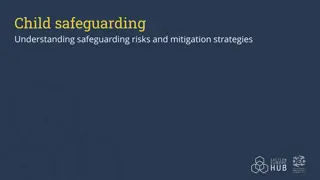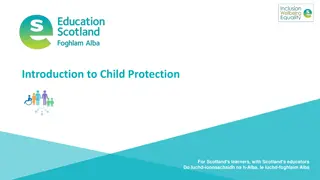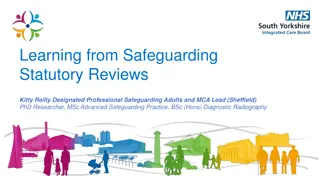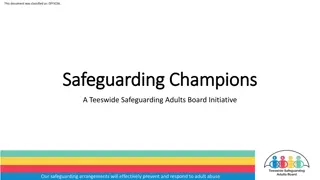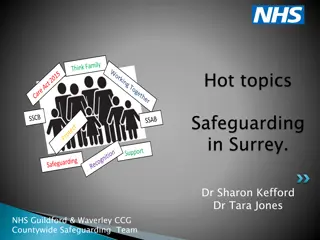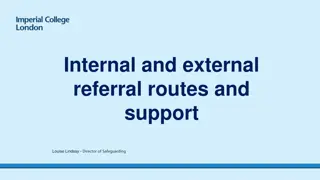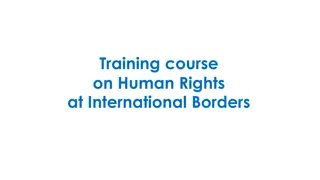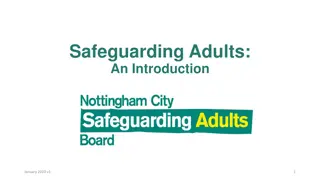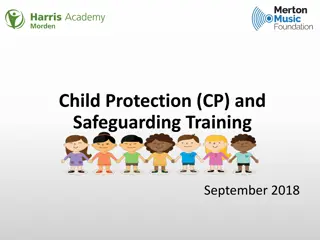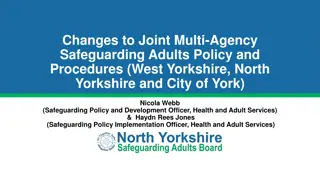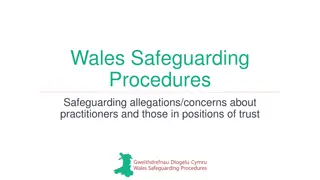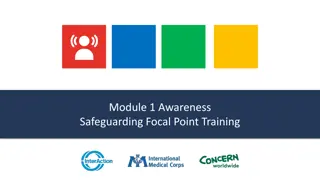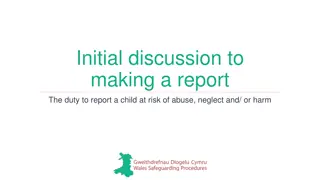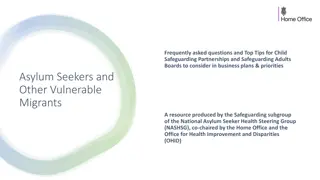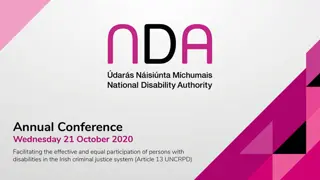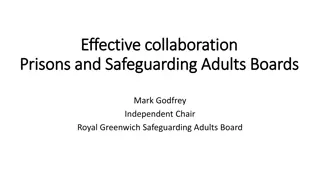Managing Safeguarding & Protection of Vulnerable Individuals
This content focuses on the importance of partnership working to protect vulnerable individuals, including explaining agreed protocols and evaluating the significance of collaboration in safeguarding practices. It delves into safeguarding boards, local authorities, the police, NHS, and community members involved in safeguarding adults within a national framework. Additionally, it discusses protocols, principles, and efficiency evaluation in partnership working for safeguarding vulnerable individuals.
Download Presentation

Please find below an Image/Link to download the presentation.
The content on the website is provided AS IS for your information and personal use only. It may not be sold, licensed, or shared on other websites without obtaining consent from the author.If you encounter any issues during the download, it is possible that the publisher has removed the file from their server.
You are allowed to download the files provided on this website for personal or commercial use, subject to the condition that they are used lawfully. All files are the property of their respective owners.
The content on the website is provided AS IS for your information and personal use only. It may not be sold, licensed, or shared on other websites without obtaining consent from the author.
E N D
Presentation Transcript
Unit 2. Unit 2. OTHM Level 5 DHCM OTHM Level 5 DHCM Managing the Safeguarding & Protection of Managing the Safeguarding & Protection of Vulnerable Individual Vulnerable Individual Learning Outcome 3. Learning Outcome 3. Department of Business & Healthcare Management Sciences Cambridge Management & Leadership School Cambridge Unit 2. OTHM L5. DHMC. LO3. Managing the Safeguarding & Protection of Vulnerable Individuals CMLS Cambridge 1
Learning Outcomes Learning Outcomes LO1. Understand the legal framework, regulations, policies and procedures that support the safeguarding and protection of vulnerable individuals. LO2. Know about the management of a service which safeguards and protects vulnerable individuals. LO3. Understand the importance of partnership working to protect vulnerable individuals. LO4. Understand how to review procedures and practices that promote safeguarding of vulnerable individuals. Unit 2. OTHM L5. DHMC. LO3. Managing the Safeguarding & Protection of Vulnerable Individuals CMLS Cambridge 2
LO. 3. Understand the importance of partnership LO. 3. Understand the importance of partnership working to protect vulnerable individuals working to protect vulnerable individuals AC. 3.1. Explain the agreed protocols for working in partnership. AC. 3.2. Evaluate the importance of working in partnership with others in relation to safeguarding and protection. Unit 2. OTHM L5. DHMC. LO3. Managing the Safeguarding & Protection of Vulnerable Individuals CMLS Cambridge 3
Indicative Contents Partnership working, safeguarding boards, local authorities, the police and the NHS, and local community members. Safeguarding adults A National Framework (2005) Evaluate efficiency: shared objectives and goals, servicer user involvement in planning; satisfaction surveys etc Unit 2. OTHM L5. DHMC. LO3. Managing the Safeguarding & Protection of Vulnerable Individuals CMLS Cambridge 4
AC. 3.1. Explain the agreed protocols for working in partnership. 1. Protocols The protocol sets out the principles underpinning how the strategic partnerships work within their defined remits, the interface between the partnerships and the practical means for effective coordination and collaboration in pursuit of interrelated priorities and how this will be sustained. 2. Principles This protocol does not seek to dilute the discreet responsibilities of each of the Partnerships. Its purpose is to ensure that the following jointly adopted principles underpin the collaborative approach of the Partnerships in order to ensure the best possible outcomes for individuals, families and communities: Unit 2. OTHM L5. DHMC. LO3. Managing the Safeguarding & Protection of Vulnerable Individuals CMLS Cambridge 5
Continued . Continued . Collectively, the Partnerships will understand the purpose and remit of each strategic partnership The Partnerships will know and understand each other s priorities and those which are shared A culture of scrutiny and challenge with exists across all Partnerships The Partnerships will work together to avoid duplication and ensure consistency Central to their decision making, the Partnerships will remain focussed on ensuring the best possible outcomes for individuals, families and communities. The Partnerships will ensure priorities are informed through agreed strategic planning approaches including data analysis and engagement with stakeholders and that where appropriate; this is shared across the strategic Partnerships. https://www.proceduresonline.com/barnsley/scb/files/inter_partnership_joint_working.pdf Unit 2. OTHM L5. DHMC. LO3. Managing the Safeguarding & Protection of Vulnerable Individuals CMLS Cambridge 6
Continued .. Continued .. 3. Partnership Functions & Responsibilities The Care Act 2014 states that Safeguarding Adults Boards by statute must: Produce a strategic plan based on the six guiding principles of the Care Act: empowerment; prevention; proportionality; protection; partnership and accountability (Barnsley Safeguarding Adults Strategic Plan 2017-18); Produce an annual summary of progress achieved against the strategic plan; Undertake Safeguarding Adults Reviews when adults die or are seriously injured as a result of abuse/neglect. https://www.proceduresonline.com/barnsley/scb/files/inter_partnership_joint_working.pdf Unit 2. OTHM L5. DHMC. LO3. Managing the Safeguarding & Protection of Vulnerable Individuals CMLS Cambridge 7
Continued . Continued . The Children Act 2004 (Section 14) states that Safeguarding Children s Boards by statute must: Coordinate what is done by each person or body represented on the Board for the purpose of safeguarding and promoting the welfare of children in the area; Ensure the effectiveness of what is done by each such person or body for the purposes of safeguarding and promoting the welfare of children. https://www.proceduresonline.com/barnsley/scb/files/inter_partnership_joint_working.pdf Unit 2. OTHM L5. DHMC. LO3. Managing the Safeguarding & Protection of Vulnerable Individuals CMLS Cambridge 8
Continued . Continued . The partnership has the following statutory duties & functions: Prepare an annual joint strategic assessment of crime, disorder, substance misuse and reoffending; Consult the community on the levels and patterns of crime, disorder, substance misuse and reoffending and on matters that need to be prioritised by the partnership. Prepare a Partnership Plan to combat crime and disorder, substance misuse and reoffending (Safer Barnsley Partnership Plan 2017-2020) Prepare an information sharing protocol; and, Coordinate Domestic Homicide Reviews. https://www.proceduresonline.com/barnsley/scb/files/inter_partnership_joint_working.pdf Unit 2. OTHM L5. DHMC. LO3. Managing the Safeguarding & Protection of Vulnerable Individuals CMLS Cambridge 9
Continued . Continued . 4. Inter-Partnership Collaboration & Co-ordination All key strategic plans referenced in Section 3 whether formulated by individual agencies or co-produced by Partnerships, have a collective aim to improve the health and wellbeing and effectively safeguard individuals, families and communities. Each Partnership / Board have defined priorities as set out in their respective strategies, however in order to ensure effective collaboration and co-ordination, adjacencies and opportunities to collaborate have been mapped and are outlined at Appendix 1. https://www.proceduresonline.com/barnsley/scb/files/inter_partnership_joint_working.pdf Unit 2. OTHM L5. DHMC. LO3. Managing the Safeguarding & Protection of Vulnerable Individuals CMLS Cambridge 10
Continued . Continued . The following table outlines how practically the principles outlined in Section 2 will be put into practice to ensure effective collaboration and coordination across the Safeguarding Adults Board, Safeguarding Children s Board, Partnership and the Stronger Communities Partnership. Note: This will be further refined following further discussion with the appropriate leads. a) Effective Coordination & Communication 6 monthly b) Information Sharing 6 monthly and Annually https://www.proceduresonline.com/barnsley/scb/files/inter_partnership_joint_working.pdf Unit 2. OTHM L5. DHMC. LO3. Managing the Safeguarding & Protection of Vulnerable Individuals CMLS Cambridge 11
Continued . Continued . 5. Review This protocol will be reviewed annually or sooner where national guidance or legislative changes is introduced affecting any of the respective Partnerships. The protocol will be reviewed by the joint Chairs meeting and will be circulated to each respective partnership for review prior to sign-off. 6. ) Signatories https://www.proceduresonline.com/barnsley/scb/files/inter_partnership_joint_working.pdf Unit 2. OTHM L5. DHMC. LO3. Managing the Safeguarding & Protection of Vulnerable Individuals CMLS Cambridge 12
AC. 3.2. Evaluate the importance of working in partnership with others in relation to safeguarding and protection. Keeping in view the following statistics, the importance becomes multifolds. These statistics are derived from data collected in the annual Children in Need Census. They provide information on children in need in England, including child protection plans and referrals to and assessments completed by children s social care services. There were 404,310 children in need in 2022 and the associated rate per 10,000 children was 334.3, or 1 in every 30 children. The latest figures represent a rise on both 2021 and 2020 and are the highest since 2018. The number of episodes starting is the highest since 2014. Both the number of episodes starting and those ending increased compared to 2021, but the number of episodes starting did so at a faster rate (8.8% compared to 5.0%). Almost half of all episodes ending in 2022 lasted 3 months or less, whereas just under 1 in 10 lasted for more than two years; this pattern is similar to previous years. https://explore-education-statistics.service.gov.uk/find-statistics/characteristics-of-children-in-need Unit 2. OTHM L5. DHMC. LO3. Managing the Safeguarding & Protection of Vulnerable Individuals CMLS Cambridge 13
Continued . Continued . The United Nations Convention on the Rights of the Child (UNCRC) is an international human rights treaty which the United Kingdom has ratified. The UNCRC sets out the fundamental rights of children. Many articles within the treaty will be applicable to any organisation which works with or provides services for children. For example, the treaty sets out the right of children to be protected from exploitation, abuse and cruel treatment. The Government in England (the Department for Education), issued statutory guidance titled 'Working Together to Safeguard Children' (2018) which should be followed in England unless there is good reason not to. This statutory guidance sets out important information regarding the legal requirements which organisations must meet in order to keep children safe. Key guidance issued by the Welsh government includes: 'Working Together to Safeguard People - information sharing to safeguard children' (2014) and the 'Wales Safeguarding Procedures . The government in Scotland issued National Guidance for Child Protection in Scotland (2021), which sets out the responsibilities of those who are involved in protecting children and provides guidance for all practitioners who support children. https://www.wonder.legal/uk/modele/safeguarding-children-policy?msclkid=eabb744d06a61b1043b910422409193e Unit 2. OTHM L5. DHMC. LO3. Managing the Safeguarding & Protection of Vulnerable Individuals CMLS Cambridge 14
Continued . Continued . The Children Act 1989 and the Children Act 2004 form the statutory footing for child protection and child welfare matters in England and Wales. Some parts of these acts also apply in Scotland, Northern Ireland. The Children and Social Work Act 2017 makes provisions about the role of the Local Authority and the welfare of children in England. The Social Services and Well-being (Wales) Act 2014 makes further specific provisions about the role of social services and child protection matters in Wales. The Children (Scotland) Act 1995, the Children and Young People (Scotland) Act 2014 form statutory footing for child protection and child welfare matters in Scotland. https://www.wonder.legal/uk/modele/safeguarding-children-policy?msclkid=eabb744d06a61b1043b910422409193e Unit 2. OTHM L5. DHMC. LO3. Managing the Safeguarding & Protection of Vulnerable Individuals CMLS Cambridge 15
Continued .. Continued .. The Children (Northern Ireland) Order 1995 and the Safeguarding Board Act (Northern Ireland) 2011 form the statutory footing for child protection and child welfare matters in Northern Ireland. The Safeguarding Vulnerable Groups (Northern Ireland) Order 2007 (as amended by the Protection of Freedoms Act 2012) sets out rules for organisations where employees, workers or volunteers are involved in regulated activities with children in Northern Ireland. The retained EU General Data Protection Regulation 2016/679 (UK GDPR) and the Data Protection Act 2018 govern the processing personal data belonging to children in the United Kingdom. https://www.wonder.legal/uk/modele/safeguarding-children-policy?msclkid=eabb744d06a61b1043b910422409193e Unit 2. OTHM L5. DHMC. LO3. Managing the Safeguarding & Protection of Vulnerable Individuals CMLS Cambridge 16
Continued .. Continued .. The government in Northern Ireland issued guidance: 'Co-operating to Safeguard Children and young people in Northern Ireland (Department of Health, 2017)' and 'Revised regional core child protection policies and procedures for Northern Ireland (Safeguarding Board for Northern Ireland, 2018)'. The Safeguarding Vulnerable Groups Act 2006 (as amended by the Protection of Freedoms Act 2012) sets out rules for organisations where employees, workers or volunteers are involved in regulated activities with children in England and Wales. Some parts of this act also apply to Scotland and Northern Ireland. The Protection of Vulnerable Groups (Scotland) Act 2007 sets out rules for organisations where employees, workers or volunteers are involved in regulated activities with children in Scotland. https://www.wonder.legal/uk/modele/safeguarding-children-policy?msclkid=eabb744d06a61b1043b910422409193e Unit 2. OTHM L5. DHMC. LO3. Managing the Safeguarding & Protection of Vulnerable Individuals CMLS Cambridge 17
Continued Continued Partnership working allows for practitioners and families to develop a relationship. It enables practitioners to get to know the family, to provide high support and yes, high challenge. The collapse in early support and preventative services, the turnover of social workers, and high reliance on temporary agency staff have consequences. The organisations operating in the United Kingdom include Governments departments voluntary and community organisations faith groups charities sports groups https://www.communitycare.co.uk/2022/01/05/working-partnership-with-families-crucial-safeguarding-interests-children/ Unit 2. OTHM L5. DHMC. LO3. Managing the Safeguarding & Protection of Vulnerable Individuals CMLS Cambridge 18
Continued . Continued . Working Together to Safeguard Children (2015), This applies to all organisations and agencies who have functions relating to children. Specifically, this guidance applies to all local authorities, clinical commissioning groups, police and all other organisations and agencies This child centred approach is fundamental to safeguarding and promoting the welfare of every child. A child centred approach means keeping the child in focus when making decisions about their lives and working in partnership with them and their families. https://assets.publishing.service.gov.uk/government/uploads/system/uploads/attachment_data/file/9424 54/Working_together_to_safeguard_children_inter_agency_guidance.pdf?trk=public_post_comment-text Unit 2. OTHM L5. DHMC. LO3. Managing the Safeguarding & Protection of Vulnerable Individuals CMLS Cambridge 19
Continued .. Continued .. Children may be vulnerable to neglect and abuse or exploitation from within their family and from individuals they come across in their day- to-day lives. These threats can take a variety of different forms, including: sexual, physical and emotional abuse; neglect; domestic abuse, including controlling or coercive behaviour; exploitation by criminal gangs and organised crime groups; trafficking; online abuse; sexual exploitation and the influences of extremism leading to radicalisation. Whatever the form of abuse or neglect, practitioners should put the needs of children first when determining what action to take. https://assets.publishing.service.gov.uk/government/uploads/system/uploads/attachment_data/file/9424 54/Working_together_to_safeguard_children_inter_agency_guidance.pdf?trk=public_post_comment-text Unit 2. OTHM L5. DHMC. LO3. Managing the Safeguarding & Protection of Vulnerable Individuals CMLS Cambridge 20
Continued .. Continued .. A co-ordinated approach safeguarding is everyone s responsibility Everyone who works with children has a responsibility for keeping them safe. No single practitioner can have a full picture of a child s needs and circumstances and, if children and families are to receive the right help at the right time, everyone who comes into contact with them has a role to play in identifying concerns, sharing information and taking prompt action. https://assets.publishing.service.gov.uk/government/uploads/system/uploads/attachment_data/file/9424 54/Working_together_to_safeguard_children_inter_agency_guidance.pdf?trk=public_post_comment-text Unit 2. OTHM L5. DHMC. LO3. Managing the Safeguarding & Protection of Vulnerable Individuals CMLS Cambridge 21
Unit 2. OTHM L5. DHMC. LO3. Managing the Safeguarding & Protection of Vulnerable Individuals CMLS Cambridge 22
